Chi-Poo: Characteristics, Care and Behavior

Designer dog breeds are becoming more and more fashionable. This is the case with the Chi-poo, a cross between a Chihuahua and the Toy or Teacup version of the Poodle. The result is a small, scruffy-haired dog with a very particular personality.
However, if you’re considering adopting one of them (there’s a high probability of finding them in a shelter, you don’t have to buy them), it would be best if you have a good idea of their characteristics. That’s precisely what you’re going to find in this article, so let’s not waste any time.
Characteristics of the Chi-poo breed

The Chi-poo (also called Choodle, Chipoodle, Poochi, or Poohuahua) is a mixed breed, that is to say, it’s not officially recognized as a breed, because it has been designed from artificial crosses. The intention was to create a dog with the advantages of both breeds.
Although the Chi-poo isn’t recognized by the American Kennel Club, it is recognized by the American Canine Hybrid Club, the Designer Dogs Kennel Club, the International Designer Canine Registry, and the Designer Breed Registry
The result is a small-sized dog, with a medium-length coat and a range of colors from cream to black, gray, brindle, or silver, among others. Their life expectancy is in accordance with their size, from 12 to 15 years.
The truth is that the general appearance of these dogs varies greatly depending on which specimens have been used in the genes. If you look at the photos, you’ll see that some have large eyes and a thin muzzle, like Chihuahuas, and others inherit the long hair and droopy ears of the Poodles. The combinations are many and varied.
History of the Chi-poo
While breed mixing has been going on for as long as breeds have existed, Chi-poo mixing began in the 1970s in the United States. In addition to the intention of creating puppies that brought together the best qualities of the Chihuahua and the Poodle, they also wanted to take advantage of the improved health that comes with mixing breeds.
The great versatility of this hybrid breed, coupled with its intelligence and affectionate nature, caused puppy sales to skyrocket. This, as you can imagine, also increased the number ending up in shelters and on the street.
General temperament
Possibly the most positive characteristic of the Chi-poo is its character. They’re energetic, sociable dogs that adapt easily to any environment, be it apartments or houses in the country. They usually create a strong bond with their guardians and enjoy doing activities with them, especially when it comes to games, sports, or training.
They’re very intelligent and it’s easy for them to learn new tricks. This type of training, in addition to how much it benefits the owners, provides a way of communicating with the dog and strengthening the bond.
Chi-poo health
Generally, the Chi-poo has good health, as it’s a mix of different breeds. However, it’s still possible for them to inherit some of the genetically related ailments from their parents. Some of the health problems found in these dogs are as follows:
- Overactive lacrimal glands or epiphora: Although excessive tearing is usually caused by an underlying disorder (such as entropion), some breeds have it congenitally.
- Hypoglycemia: This is a sudden drop in blood glucose concentration. It’s typical in young Chihuahuas, and requires immediate veterinary attention, as the dog’s life may be in danger.
- Glaucoma: The increase of excessive intraocular pressure that eventually presses on the optic nerve and causes blindness.
- Patellar dislocation: This pathology is characterized by the abnormal alignment of this bone, either due to deformities during development or trauma, among others.
On the other hand, small breeds tend to have digestive problems if given a poor diet, as well as dental problems. Take this into account in day-to-day care and veterinary check-ups.
Special care

Although the Chi-poo has been designed to be cared for as easily as possible, certain care can’t be ignored in order to ensure that they have the highest possible quality of life.
First of all, be sure to give them quality feed and distribute them in several feedings a day, as well as brushing its teeth daily.
As we said earlier, it’s an energetic dog, so they need their daily exercise. Besides, their minds also need feeding, that’s to say, you should socialize with them, play together and provide them with entertainment for the times they need to be alone.
In houses with children, it’s a good idea to establish clear guidelines when relating to them, because sometimes accidents happen due to their small size. The Chi-poo will have no problem in relating to the whole family, but it should be trained to respect both humans and other dogs.
As you can see, the Chi-poo is an ideal dog for many types of people, so don’t hesitate to adopt one of them if you have the opportunity. They’re affectionate, funny, intelligent, and, above all, deserving of a better life by your side.
Designer dog breeds are becoming more and more fashionable. This is the case with the Chi-poo, a cross between a Chihuahua and the Toy or Teacup version of the Poodle. The result is a small, scruffy-haired dog with a very particular personality.
However, if you’re considering adopting one of them (there’s a high probability of finding them in a shelter, you don’t have to buy them), it would be best if you have a good idea of their characteristics. That’s precisely what you’re going to find in this article, so let’s not waste any time.
Characteristics of the Chi-poo breed

The Chi-poo (also called Choodle, Chipoodle, Poochi, or Poohuahua) is a mixed breed, that is to say, it’s not officially recognized as a breed, because it has been designed from artificial crosses. The intention was to create a dog with the advantages of both breeds.
Although the Chi-poo isn’t recognized by the American Kennel Club, it is recognized by the American Canine Hybrid Club, the Designer Dogs Kennel Club, the International Designer Canine Registry, and the Designer Breed Registry
The result is a small-sized dog, with a medium-length coat and a range of colors from cream to black, gray, brindle, or silver, among others. Their life expectancy is in accordance with their size, from 12 to 15 years.
The truth is that the general appearance of these dogs varies greatly depending on which specimens have been used in the genes. If you look at the photos, you’ll see that some have large eyes and a thin muzzle, like Chihuahuas, and others inherit the long hair and droopy ears of the Poodles. The combinations are many and varied.
History of the Chi-poo
While breed mixing has been going on for as long as breeds have existed, Chi-poo mixing began in the 1970s in the United States. In addition to the intention of creating puppies that brought together the best qualities of the Chihuahua and the Poodle, they also wanted to take advantage of the improved health that comes with mixing breeds.
The great versatility of this hybrid breed, coupled with its intelligence and affectionate nature, caused puppy sales to skyrocket. This, as you can imagine, also increased the number ending up in shelters and on the street.
General temperament
Possibly the most positive characteristic of the Chi-poo is its character. They’re energetic, sociable dogs that adapt easily to any environment, be it apartments or houses in the country. They usually create a strong bond with their guardians and enjoy doing activities with them, especially when it comes to games, sports, or training.
They’re very intelligent and it’s easy for them to learn new tricks. This type of training, in addition to how much it benefits the owners, provides a way of communicating with the dog and strengthening the bond.
Chi-poo health
Generally, the Chi-poo has good health, as it’s a mix of different breeds. However, it’s still possible for them to inherit some of the genetically related ailments from their parents. Some of the health problems found in these dogs are as follows:
- Overactive lacrimal glands or epiphora: Although excessive tearing is usually caused by an underlying disorder (such as entropion), some breeds have it congenitally.
- Hypoglycemia: This is a sudden drop in blood glucose concentration. It’s typical in young Chihuahuas, and requires immediate veterinary attention, as the dog’s life may be in danger.
- Glaucoma: The increase of excessive intraocular pressure that eventually presses on the optic nerve and causes blindness.
- Patellar dislocation: This pathology is characterized by the abnormal alignment of this bone, either due to deformities during development or trauma, among others.
On the other hand, small breeds tend to have digestive problems if given a poor diet, as well as dental problems. Take this into account in day-to-day care and veterinary check-ups.
Special care

Although the Chi-poo has been designed to be cared for as easily as possible, certain care can’t be ignored in order to ensure that they have the highest possible quality of life.
First of all, be sure to give them quality feed and distribute them in several feedings a day, as well as brushing its teeth daily.
As we said earlier, it’s an energetic dog, so they need their daily exercise. Besides, their minds also need feeding, that’s to say, you should socialize with them, play together and provide them with entertainment for the times they need to be alone.
In houses with children, it’s a good idea to establish clear guidelines when relating to them, because sometimes accidents happen due to their small size. The Chi-poo will have no problem in relating to the whole family, but it should be trained to respect both humans and other dogs.
As you can see, the Chi-poo is an ideal dog for many types of people, so don’t hesitate to adopt one of them if you have the opportunity. They’re affectionate, funny, intelligent, and, above all, deserving of a better life by your side.
All cited sources were thoroughly reviewed by our team to ensure their quality, reliability, currency, and validity. The bibliography of this article was considered reliable and of academic or scientific accuracy.
- Bellumori, TP, Famula, TR, Bannasch, DL, Belanger, JM y Oberbauer, AM (2013). Prevalencia de trastornos hereditarios entre perros mestizos y de pura raza: 27.254 casos (1995-2010). Diario de la Asociación Médica Veterinaria Americana, 242 (11), 1549-1555.
- Frejlich, M., Capiau, E., & Van Ham, L. (2020). Primary glaucoma in the dog: a review of the current therapies and the research into future possibilities: Part I: medical therapy. Vlaams Diergeneeskundig Tijdschrift, 89(1).
- GLAZKO, T., Kosovsky, G. Y., Blokhina, T. V., Zhirkova, A. A., & Glazko, T. T. (2021). SOCIALIZATION AND GENETIC VARIABILITY AS A DRIVER OF DOMESTICATION (BY THE EXAMPLE OF DOG BREEDS). Sel’skokhozyaistvennaya Biologiya [Agricultural Biology], 56(1), 292-303.
This text is provided for informational purposes only and does not replace consultation with a professional. If in doubt, consult your specialist.








